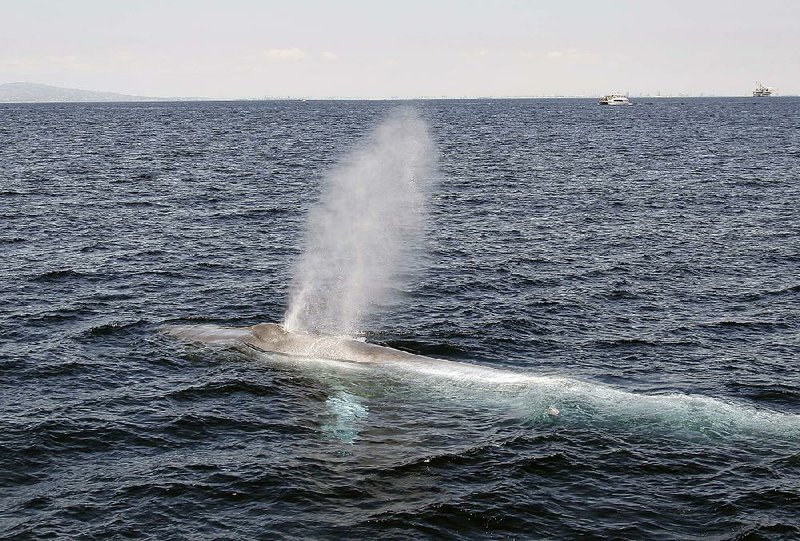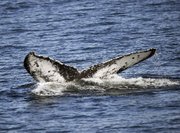Humans have the privilege of sharing the planet with the largest animal that ever lived on earth.
The great blue whale, which can be found in every ocean around the globe, is bigger than any dinosaur seen in a museum.
It can weigh as much as 24 elephants and can grow to up to two school buses in length.
Its jawbone is as big as a telephone pole, its heart is the size of an oil drum, and it can consume up to 2 tons of food in a single day.
"There's no way to describe how insignificant you feel when you are around an animal this big," said Ari Friedlaender, an ecologist at Oregon State University's Marine Mammal Institute.
But exactly when whales became the largest animals on the planet -- and why -- has been a mystery. Until now.
In a paper published in Proceedings of the Royal Society B, a team of scientists suggests that smaller baleen whales that swam the ancient seas were uniquely positioned to take advantage of a change in the distribution of food in the ocean that occurred roughly 3 million years ago -- but only if they grew bigger.
"What the paper shows is that whales didn't get bigger and bigger as soon as they entered the ocean or when they evolved filter feeding," said Friedlaender, who was not involved with the new research. "Instead, there was a time when resources increased very quickly, and that was concurrent with when they got big."
Baleen whales -- which include great blue whales, fin whales and right whales, among others -- are amazingly efficient eaters. Their favorite feast is krill, a shrimplike animal about the size of a bumblebee that can assemble in a dense swarm hundreds of feet thick and more than a mile in length.
Hungry whales accelerate into this swarm with their enormous mouths open, eventually filtering out the water and swallowing the krill. Using this technique, the biggest whales can ingest half a million calories in a single bite.
"People like to say, 'Oh, the biggest animals in the ocean eat the smallest animals,' but if you ever see a blue whale eat, it's almost like it's taking a bite out of a super organism," said Nick Pyenson, curator of fossil marine mammals at the Smithsonian's National Museum of Natural History.
And yet, that hasn't always been the case.
Pyenson's own work measuring more than 140 fossil specimens of whales, some of which date as far back as 30 million years, showed that for most of their evolutionary history, baleen whales were much smaller than they are today -- closer in size to a minivan than a bus or bigger.
It isn't until somewhere between 3.5 million and 100,000 years ago that distantly related baleen whales all started to grow to jumbo size, and smaller whales started to die out. So what affected this change?
The researchers considered several possibilities that have been used to explain gigantism in other animals. For example, Cope's rule posits that species have a tendency to get bigger over time. But this didn't explain the data. Thanks to Pyenson's research, the scientists knew that whales stayed relatively small for most of their history and then suddenly got large all at once.
Another hypothesis known as the Brownian motion model of evolution posits that animals get big and small at random. In this scenario, the descendants of an animal would be both larger and smaller than their ancestor, but this didn't fit with the data either, since whales got only bigger.
Pyenson's co-author Graham Slater, an evolutionary biologist at the University of Chicago who did the evolutionary modeling, thought perhaps whale size was influenced by drops in ocean temperature.
"I really thought we might find some signature effect of temperature because it just made sense," Slater said. "But in the end, it is more exciting that temperature didn't play a role because it meant that we had to find something new to explain what was going on."
After looking at fossil data in ocean sediments, the scientists ultimately concluded that whales expanded in size as a response to a change in the way their food supply was distributed in the ocean. As Slater explains, from the time of the dinosaurs to about 3 million years ago, nutrients were evenly distributed across the ocean. But then there is a transition in which dense aggregations of nutrients can be found along certain coastlines, while vast parts of the open ocean are virtual marine deserts.
This change occurs because of the slow cooling of the earth that began after the dinosaurs became extinct. Eventually this cooling leads to ice at the northern pole, which melts in summer, sending nutrients from the land into the sea.
At the same time, wind patterns change so that breezes blowing off the coasts push warm, surface water toward the center of the ocean and allow upwelling of cooler, nutrient-rich water. This promotes the primary production of plant life, which in turn feeds the krill and allows them to assemble in enormous swarms.
In this environment, it is better to be a large baleen whale than a small baleen whale for a couple of reasons. Bigger whales can take larger bites of dense krill patches. In addition, their large size allows them to keep more fat in storage to sustain them as they travel to the next krill assemblage.
SundayMonday on 05/28/2017

